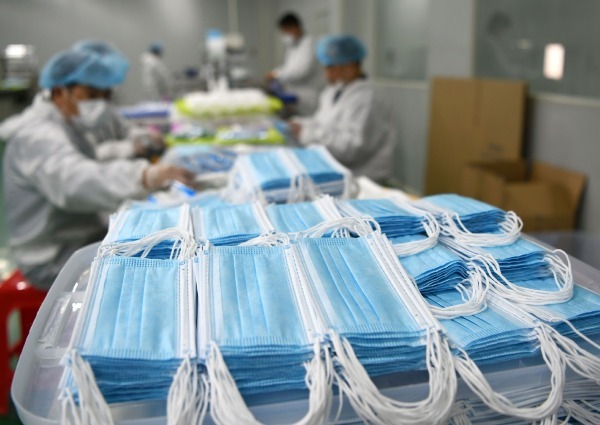
Os trabalhadores fazem máscaras de proteção médica em uma fábrica em Nanchang, Província de Jiangxi. [Foto de Hu Guolin/para a China Daily]
Um vídeo, A reivindicação dos processos de esterilização das máscaras deixam carcinógenos nos produtos, levantou preocupações entre o público em geral na semana passada. Então, O que exatamente acontece durante a produção de máscara? É realmente uma causa de preocupação?
1. O que é usado para esterilizar máscaras?
Médico máscaras são esterilizados de várias maneiras, inclusive com radiação, óxido de etileno, vapor e outros métodos.
A maioria das máscaras médicas e N95 disponíveis no mercado são esterilizadas por óxido de etileno (Alinhar). É um método importante de esterilização que os fabricantes usam amplamente para manter os dispositivos médicos seguros.
2. O resíduo de óxido de etileno pode causar máscaras causando efeitos imediatos/agudos à saúde?
Somente a exposição a longo prazo e ocupacional à ETO foi associada ao câncer em estudos de pesquisa.
Para os principais fabricantes que seguem os padrões e diretrizes de produção, O nível de ETO residual deixado em uma máscara depois de sofrer esterilização de ETO está dentro dos limites seguros.
3. Quanto tempo o óxido de etileno permanece no corpo?
EtO é eliminado do corpo rapidamente - com níveis caindo 50 porcentagem a cada 42 minutos. Nesse ritmo, quase 90 porcentagem de ETO desapareceria do corpo depois de duas horas.
4. É necessário sacudir uma máscara antes de usá -la?
Não é necessário sacudir uma máscara antes de usá -la.
Sacudir as máscaras ou secá -las sob o sol antes de usá -las é uma escolha pessoal. Essas ações geralmente não impedem o efeito protetor da máscara.
Os funcionários médicos não agitam suas máscaras porque uma máscara é estéril quando retirada do pacote. Deliberately shaking and exposing it in the air can cause unintended contamination in places such as hospitals.
5. Qual é a recomendação científica para o uso de máscara?
– Pessoas que não estão em um ambiente de alto risco, como em contato direto com doenças respiratórias, geralmente não precisam usar máscaras N95.
– Em lugares onde o vírus pode estar presente, como hospitais, quartos fechados, e áreas de risco médio, Vestir uma máscara médica é suficiente.
– Recomenda -se trocar de máscara diariamente.
– Quando não está usando uma máscara, As pessoas podem pendurar a máscara ou ajudar a preservá -la usando uma toalha de papel limpa.
– Para a prevenção de doenças respiratórias e digestivas, Usar máscaras sozinho não é suficiente. As pessoas devem prestar atenção à higiene das mãos e lavar as mãos com frequência.
6. As máscaras feitas por fabricantes menores atendem aos padrões de segurança do nível de óxido de etileno?
Os custos dos dispositivos de esterilização de eTO são altos, Portanto, os fabricantes menores geralmente usam outros métodos de esterilização.
Para máscaras mal feitas, A higiene do produto representa mais preocupações de saúde do que o nível de ETO, pode conter.
Fonte: Chinadaily

















